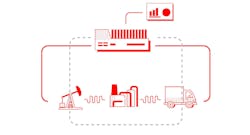Unlock single well and field-wide productivity with optimized artificial lift
In today’s complex energy landscape, oil and gas operators must find innovative ways to improve operational efficiency and reduce capital expenses. To accomplish this, best practices in the field are supported by additional engineering criteria. Digital breakthroughs, such as adaptive, high-science applications and intelligent workflows that optimize well planning and operations are essential to success.
Each well drilled, stimulated, and completed represents a significant investment in time and resources. The production phase of your oil and gas wells is critical to unlocking its full economic potential and, ultimately, optimizing your return on investment. As such, it’s crucial to ensure the healthy operation of each well by continually evaluating artificial lift operations and overall production optimization over the complete life cycle.
Visualize, evaluate, and maximize production performance
Regardless of your expertise and data availability, the cloud-enabled Delfi cognitive E&P environment delivers on-demand tools to improve your ability to meet production targets safely and efficiently. With advanced production applications like the built-in PIPESIM steady-state multiphase flow simulator, you can get the most out of your wells by creating rapid well models, evaluating well performance, enhancing artificial lift system design, optimizing equipment maintenance scheduling, and more.
- Scenario 1: Artificial lift design and well modeling - By inputting basic well information, such as casing, tubing, completions, and deviation, into the PIPESIM simulator, users can create a simple well model and perform a NODAL analysis to evaluate operational conditions, forecast the performance of various artificial lift systems, and identify means of improving production efficiency.
- Scenario 2: Artificial lift performance and network optimization - Building on information from the NODAL analysis, you can visualize and evaluate well and network performance. Within the PIPESIM simulator, you can review an individual well’s flow pattern, conditions, and GOR to decide on how to improve the performance of your ESP pumps and gas lift operations. You can also analyze network-wide performance to gain an integrated view of the field and meet objective functions.
- Scenario 3: Automation of debottlenecking and model updates for operations - To unlock your asset’s actual value, you need to streamline the operation and management of your production operations. The Delfi environment’s automation capabilities enable you to improve efficiency and reduce the risk of human error by connecting directly with your data. In addition, advanced workflows allow for the visualization of different variables over time, so you gain a deeper understanding of your field.
Learn how to get the most out of your wells. Watch each of these scenarios in more detail to see how your data can help you optimize production, maximize recovery, and improve well economics for years to come.


